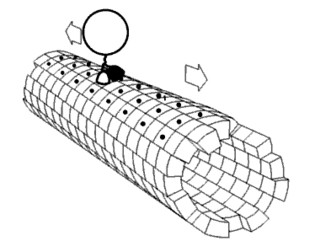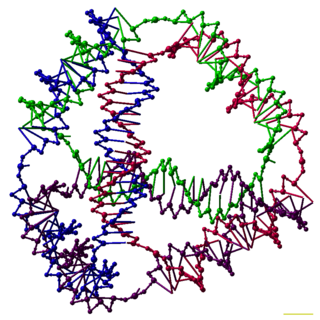Related Research Articles

A carbon nanotube (CNT) is a tube made of carbon with a diameter in the nanometre range (nanoscale). They are one of the allotropes of carbon. Two broad classes of carbon nanotubes are recognized:

Nanotechnology is the manipulation of matter with at least one dimension sized from 1 to 100 nanometers (nm). At this scale, commonly known as the nanoscale, surface area and quantum mechanical effects become important in describing properties of matter. This definition of nanotechnology includes all types of research and technologies that deal with these special properties. It is common to see the plural form "nanotechnologies" as well as "nanoscale technologies" to refer to research and applications whose common trait is scale. An earlier understanding of nanotechnology referred to the particular technological goal of precisely manipulating atoms and molecules for fabricating macroscale products, now referred to as molecular nanotechnology.

Biomimetics or biomimicry is the emulation of the models, systems, and elements of nature for the purpose of solving complex human problems. The terms "biomimetics" and "biomimicry" are derived from Ancient Greek: βίος (bios), life, and μίμησις (mīmēsis), imitation, from μιμεῖσθαι (mīmeisthai), to imitate, from μῖμος (mimos), actor. A closely related field is bionics.

Nanoelectromechanical systems (NEMS) are a class of devices integrating electrical and mechanical functionality on the nanoscale. NEMS form the next logical miniaturization step from so-called microelectromechanical systems, or MEMS devices. NEMS typically integrate transistor-like nanoelectronics with mechanical actuators, pumps, or motors, and may thereby form physical, biological, and chemical sensors. The name derives from typical device dimensions in the nanometer range, leading to low mass, high mechanical resonance frequencies, potentially large quantum mechanical effects such as zero point motion, and a high surface-to-volume ratio useful for surface-based sensing mechanisms. Applications include accelerometers and sensors to detect chemical substances in the air.

Nanoid robotics, or for short, nanorobotics or nanobotics, is an emerging technology field creating machines or robots, which are called nanorobots or simply nanobots, whose components are at or near the scale of a nanometer. More specifically, nanorobotics refers to the nanotechnology engineering discipline of designing and building nanorobots with devices ranging in size from 0.1 to 10 micrometres and constructed of nanoscale or molecular components. The terms nanobot, nanoid, nanite, nanomachine and nanomite have also been used to describe such devices currently under research and development.

A nanoparticle or ultrafine particle is a particle of matter 1 to 100 nanometres (nm) in diameter. The term is sometimes used for larger particles, up to 500 nm, or fibers and tubes that are less than 100 nm in only two directions. At the lowest range, metal particles smaller than 1 nm are usually called atom clusters instead.

Electrospinning is a fiber production method that uses electrical force to draw charged threads of polymer solutions for producing nanofibers with diameters ranging from nanometers to micrometers. Electrospinning shares characteristics of both electrospraying and conventional solution dry spinning of fibers. The process does not require the use of coagulation chemistry or high temperatures to produce solid threads from solution. This makes the process particularly suited to the production of fibers using large and complex molecules. Electrospinning from molten precursors is also practiced; this method ensures that no solvent can be carried over into the final product.
A non-carbon nanotube is a cylindrical molecule often composed of metal oxides, or group III-Nitrides and morphologically similar to a carbon nanotube. Non-carbon nanotubes have been observed to occur naturally in some mineral deposits.

DNA origami is the nanoscale folding of DNA to create arbitrary two- and three-dimensional shapes at the nanoscale. The specificity of the interactions between complementary base pairs make DNA a useful construction material, through design of its base sequences. DNA is a well-understood material that is suitable for creating scaffolds that hold other molecules in place or to create structures all on its own.

Nanochemistry is an emerging sub-discipline of the chemical and material sciences that deals with the development of new methods for creating nanoscale materials. The term "nanochemistry" was first used by Ozin in 1992 as 'the uses of chemical synthesis to reproducibly afford nanomaterials from the atom "up", contrary to the nanoengineering and nanophysics approach that operates from the bulk "down"'. Nanochemistry focuses on solid-state chemistry that emphasizes synthesis of building blocks that are dependent on size, surface, shape, and defect properties, rather than the actual production of matter. Atomic and molecular properties mainly deal with the degrees of freedom of atoms in the periodic table. However, nanochemistry introduced other degrees of freedom that controls material's behaviors by transformation into solutions. Nanoscale objects exhibit novel material properties, largely as a consequence of their finite small size. Several chemical modifications on nanometer-scaled structures approve size dependent effects.
Nanoelectronics refers to the use of nanotechnology in electronic components. The term covers a diverse set of devices and materials, with the common characteristic that they are so small that inter-atomic interactions and quantum mechanical properties need to be studied extensively. Some of these candidates include: hybrid molecular/semiconductor electronics, one-dimensional nanotubes/nanowires or advanced molecular electronics.
Self-assembling peptides are a category of peptides which undergo spontaneous assembling into ordered nanostructures. Originally described in 1993, these designer peptides have attracted interest in the field of nanotechnology for their potential for application in areas such as biomedical nanotechnology, tissue cell culturing, molecular electronics, and more.

DNA nanotechnology is the design and manufacture of artificial nucleic acid structures for technological uses. In this field, nucleic acids are used as non-biological engineering materials for nanotechnology rather than as the carriers of genetic information in living cells. Researchers in the field have created static structures such as two- and three-dimensional crystal lattices, nanotubes, polyhedra, and arbitrary shapes, and functional devices such as molecular machines and DNA computers. The field is beginning to be used as a tool to solve basic science problems in structural biology and biophysics, including applications in X-ray crystallography and nuclear magnetic resonance spectroscopy of proteins to determine structures. Potential applications in molecular scale electronics and nanomedicine are also being investigated.

Peptide amphiphiles (PAs) are peptide-based molecules that self-assemble into supramolecular nanostructures including; spherical micelles, twisted ribbons, and high-aspect-ratio nanofibers. A peptide amphiphile typically comprises a hydrophilic peptide sequence attached to a lipid tail, i.e. a hydrophobic alkyl chain with 10 to 16 carbons. Therefore, they can be considered a type of lipopeptide. A special type of PA, is constituted by alternating charged and neutral residues, in a repeated pattern, such as RADA16-I. The PAs were developed in the 1990s and the early 2000s and could be used in various medical areas including: nanocarriers, nanodrugs, and imaging agents. However, perhaps their main potential is in regenerative medicine to culture and deliver cells and growth factors.
Tube-based nanostructures are nanolattices made of connected tubes and exhibit nanoscale organization above the molecular level.
Jackie Yi-Ru Ying is an American nanotechnology scientist based in Singapore. She is the founding executive director of the Institute of Bioengineering and Nanotechnology (IBN).
Bio-inks are materials used to produce engineered/artificial live tissue using 3D printing. These inks are mostly composed of the cells that are being used, but are often used in tandem with additional materials that envelope the cells. The combination of cells and usually biopolymer gels are defined as a bio-ink. They must meet certain characteristics, including such as rheological, mechanical, biofunctional and biocompatibility properties, among others. Using bio-inks provides a high reproducibility and precise control over the fabricated constructs in an automated manner. These inks are considered as one of the most advanced tools for tissue engineering and regenerative medicine (TERM).
Thomas J. Webster is an American biomedical engineer, researcher, and entrepreneur. Throughout his over 25-year academic career, his research group has produced several books and book chapters. He has over 1350 publications and has an H-index of 118. This high H-index places him amongst the top 1% of researchers in his field.
Indium(II) selenide (InSe) is an inorganic compound composed of indium and selenium. It is a III-VI layered semiconductor. The solid has a structure consisting of two-dimensional layers bonded together only by van der Waals forces. Each layer has the atoms in the order Se-In-In-Se.
Bioprinting drug delivery is a method for producing drug delivery vehicles. It uses three-dimensional printing of biomaterials via additive manufacturing. Such vehicles are biocompatible, tissue-specific hydrogels or implantable devices. 3D bioprinting prints cells and biological molecules to form tissues, organs, or biological materials in a scaffold-free manner that mimics living human tissue. The technique allows targeted disease treatments with scalable and complex geometry.
References
- ↑ Suwan N Jayasinghe (2007). "Direct cell engineering reaches the jet age". Materials Today. 10 (6): 60. doi: 10.1016/S1369-7021(07)70159-1 .
- ↑ Suwan N Jayasinghe (2006). "An advanced jet-based approach to processing nanotubes". Physica E. 31 (1): 17–26. doi:10.1016/j.physe.2005.08.013.
- ↑ Suwan N Jayasinghe (2006). "A novel technique for forming self-assembled nanotube structures". Fullerenes, Nanotubes, and Carbon Nanostructures. 14 (1): 67–81. doi:10.1080/15363830500538524. S2CID 136903955.
- ↑ Suwan N Jayasinghe (2006). "Self-assembled nanostructures via electrospraying". Physica E. 33 (2): 398–406. doi:10.1016/j.physe.2006.04.011.
- ↑ Suwan N Jayasinghe (2008). "Electrospray self-assembly: An emerging jet-based route for directly forming nanoscaled structures". Physica E. 40 (9): 2911–2915. doi:10.1016/j.physe.2008.02.005.
- ↑ R Pareta; A Brindley; MJ Edirisinghe; SN Jayasinghe; ZB Luklinska (2005). "Electrohydrodynamic atomization of protein (bovine serum albumin)". Journal of Materials Science: Materials in Medicine. 16 (10): 919–925. doi:10.1007/s10856-005-4426-z. PMID 16167100. S2CID 42213925.
- ↑ Peter AM Eagles; Amer N Quresh; Suwan N. Jayasinghe (2006). "Electrohydrodynamic jetting of mouse neuronal cells". Biochemical Journal. 394 (2): 375–378. doi:10.1042/BJ20051838. PMC 1408668 . PMID 16393140.
- ↑ Napachanok Mongkoldhumrongkul; James M Flanagan; Suwan N Jayasinghe (2009). "Direct jetting approaches for handling stem cells". Biomedical Materials. 4 (1): 015018. doi:10.1088/1748-6041/4/1/015018. PMID 19193972. S2CID 22508896.
- ↑ Anil Abeyewickreme; Albert Kwok; Jean R. McEwan; Suwan N. Jayasinghe (2009). "Bio-electrospraying embryonic stem cells: interrogating cellular viability and pluripotency". Biomedical Materials. 4 (1): 015018. doi:10.1088/1748-6041/4/1/015018. PMID 19193972. S2CID 22508896.
- ↑ Jonathan DW Clarke; Suwan N Jayasinghe (2008). "Bio-electrosprayed multicellular zebrafish embryos are viable and develop normally". Biomedical Materials. 3 (1): 011001. doi:10.1088/1748-6041/3/1/011001. PMID 18458487. S2CID 3365967.
- ↑ Timothy J. Geach; Napachanok Mongkoldhumrongkul; Lyle B. Zimmerman; Suwan N Jayasinghe (2009). "Bio-electrospraying living Xenopus tropicalis embryos: investigating the structural, functional and biological integrity of a model organism". Analyst. 134 (4): 743–747. doi:10.1039/b817827e. PMID 19305925.
- ↑ Helena Kempski; Nicola Austin; Amy Roe; Steve Chatters; Suwan N Jayasinghe (2008). "Pilot study to investigate the possibility of cytogenetic and physiological changes in bio-electrosprayed human lymphocyte cells". Regenerative Medicine. 3 (3): 343–349. doi:10.2217/17460751.3.3.343. PMID 18462057.
- ↑ Richard P. Hall; Caroline M. Ogilvie; Emma Aarons; Suwan N. Jayasinghe (2008). "Genetic, genomic and physiological state studies on single-needle bio-electrosprayed human cells". Analyst. 133 (10): 1347–1351. doi:10.1039/b806901h. PMID 18810280.
- ↑ Duncan Greig; Suwan N Jayasinghe (2008). "Genomic, genetic and physiological effects of bio-electrospraying on live cells of the model yeast Saccharomyces cerevisiae". Biomedical Materials. 3 (3): 034125. doi:10.1088/1748-6041/3/3/034125. PMID 18765897. S2CID 5346587.